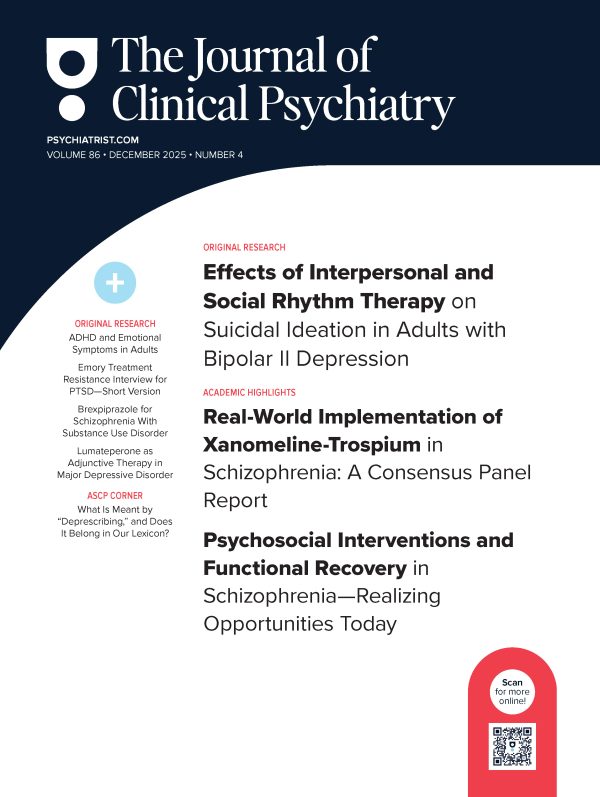Abstract
Objective: To investigate racial disparities in the first-time prescription of mood stabilizers for first-episode mania in nonpsychotic, hospitalized patients with bipolar I disorder, specifically comparing the rates of lithium and valproic acid prescription between non-Hispanic Black and non-Hispanic White patients.
Methods: A retrospective cohort study was conducted using the TriNetX database. We included eligible hospitalized non Hispanic Black and non-Hispanic White patients newly diagnosed with bipolar I disorder without psychotic features between January 1, 2014, and December 31, 2023. Propensity score matching was employed to create balanced comparison populations of non-Hispanic Black and non-Hispanic White patients, controlling for factors that may influence medication selection. A measure of association analysis was performed to calculate and compare the fraction of patients with either lithium or valproic acid use in both cohorts. Odds ratios were assessed.
Results: The study included 1,582 patients (N = 791 per cohort). After propensity matching, baseline characteristics were well balanced. Lithium was prescribed to 24% of White patients compared to 15% of Black patients (odds ratio [OR] 1.82, 95% CI, 1.41–2.35, P < .05). Conversely, valproic acid was prescribed to 20% of Black patients compared to 12% of White patients (OR 0.53 95% CI, 0.40–0.71, P < .05).
Conclusions: Significant disparities in the prescription rates of valproic acid and lithium were observed, with Black patients more likely to receive valproic acid and less likely to receive lithium compared to their White counterparts. Efforts to address these inequities should involve addressing structural, patient-related, and clinician-related factors that may contribute to our findings.
J Clin Psychiatry 2025;86(1):24m15524
Author affiliations are listed at the end of this article.
Members Only Content
This full article is available exclusively to Professional tier members. Subscribe now to unlock the HTML version and gain unlimited access to our entire library plus all PDFs. If you’re already a subscriber, please log in below to continue reading.
References (18)

- National Institute of Mental Health (NIMH). Bipolar Disorder. Accessed May 29, 2024. https://www.nimh.nih.gov/health/statistics/bipolar-disorder
- Yatham LN, Kennedy SH, Parikh SV, et al. Canadian Network for Mood and Anxiety Treatments (CANMAT) and International Society for Bipolar Disorders (ISBD) 2018 guidelines for the management of patients with bipolar disorder. Bipolar Disord. 2018;20(2):97–170. CrossRef
- Tchikrizov V, Ladner ME, Caples FV, et al. Health disparities in the treatment of bipolar disorder. Personalized Med Psychiatry. 2023;37–38:100101. PubMed CrossRef
- Depp C, Ojeda VD, Mastin W, et al. Trends in use of antipsychotics and mood stabilizers among Medicaid beneficiaries with bipolar disorder, 2001–2004. Psychiatr Serv. 2008;59(10):1169–1174. PubMed CrossRef
- Gonzalez Arnold J, Salcedo S, Ketter TA, et al. An exploratory study of responses to low-dose lithium in African Americans and Hispanics. J Affect Disord. 2015;178:224–228. PubMed CrossRef
- Busch AB, Frank RG, Sachs G, et al. Bipolar-I patient characteristics associated with differences in antimanic medication prescribing. Psychopharmacol Bull. 2009;42(1):35–49. PubMed
- Akinhanmi M, El-Amin S, Balls-Berry JE, et al. Decreased core symptoms of mania and utilization of lithium/mood stabilizing anticonvulsants in U.S. bipolar I patients of African vs European ancestry. J Affect Disord. 2020;260:361–365. PubMed CrossRef
- Haukoos JS, Lewis RJ. The propensity score. JAMA. 2015;314(15):1637–1638. CrossRef
- Divalproex sodium. Package insert. Abbvie Inc; 2024.
- Lithium carbonate. Package insert. Westward Pharmaceuticals; 2018.
- Survey on Racism, Discrimination and Health - Findings - 10257 | KFF. Accessed July 9, 2024. https://www.kff.org/report-section/survey-on-racism-discriminationand-health-findings/
- Maddox KB. Perspectives on racial phenotypicality bias. Pers Soc Psychol Rev. 2004;8(4):383–401. PubMed CrossRef
- Schwarz C, Volz A, Li C, et al. Valproate for schizophrenia. Cochrane Database Syst Rev. 2008(3):CD004028. PubMed
- American Psychiatric Association. Historical Addendum to APA’s Apology to Black, Indigenous and People of Color for Its Support of Structural Racism in Psychiatry. January 18, 2021. Accessed May 29, 2024. https://www.psychiatry.org/news-room/historical-addendum-to-apa-apology
- Amutah C, Greenidge K, Mante A, et al. Misrepresenting race - the role of medical schools in propagating physician bias. N Engl J Med. 2021;384(9):872–878. PubMed CrossRef
- Bailey RK. Best Practice Highlights African Americans/Blacks. American Psychiatric Association; 2021. Accessed May 29, 2024. http://www.psychiatry.org/FileLibrary/Psychiatrists/Cultural-Competency/Treating-Diverse-Populations/Best-Practices-AfricanAmerican-Patients.pdf
- Moore C, Coates E, Watson A, et al. “It’s important to work with people that look like me”: black patients’ preferences for patient-provider race concordance. J Racial Ethn Health Disparities. 2023;10(5):2552–2564.
- Ruiz-White I, Kramer L, Philips L, et al. Racial and ethnic disparities in physical and mental health care and clinical trials. J Clin Psychiatry. 2023;84(4):23ah14887. PubMed CrossRef





